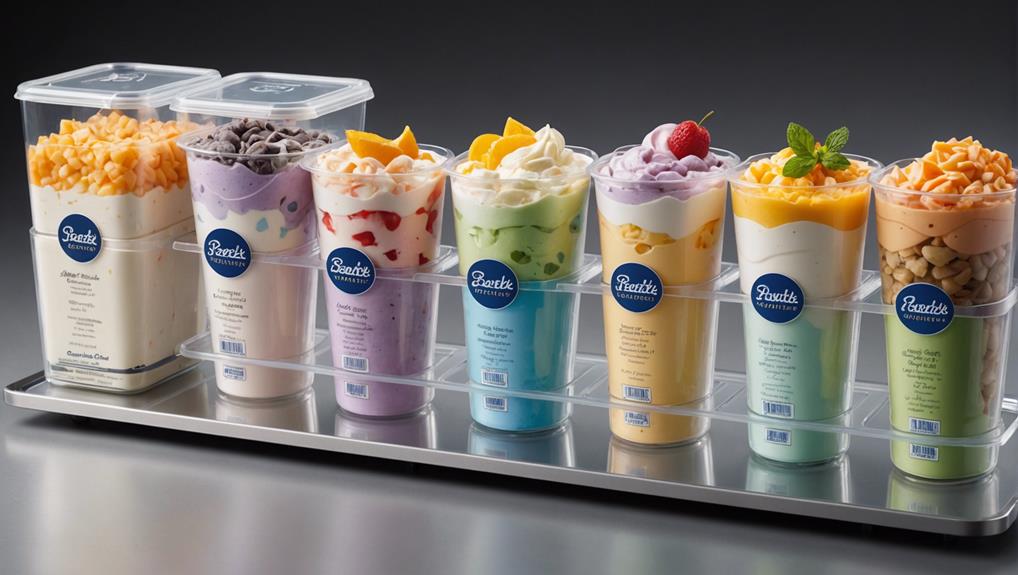Sugar-free frozen yogurt is a nutritious alternative to traditional frozen desserts. Made with full-fat Greek yogurt, it is rich in protein and probiotics, supporting gut health. Allulose or xylitol sweeteners provide sweetness without added carbs, making it suitable for low-carb diets. Flavor variations, such as cocoa and fruits, can enhance both taste and nutrient profile. Toppings like berries and nuts add antioxidants, healthy fats, and fiber. Proper storage in an airtight container guarantees it remains fresh for up to 2 months. If you are interested in creating a health-focused dessert tailored to individual tastes, there are various aspects to contemplate.
Key Takeaways
- Use full-fat Greek yogurt for a rich, creamy texture and added protein.
- Allulose sweetener provides zero-carb sweetness without affecting blood sugar levels.
- Flavor variations like cocoa, fruits, and vanilla extract enhance taste.
- Serve with toppings like berries and nuts for added nutrition.
- Store in an airtight container in the freezer for up to 2 months.
Ingredients

When preparing sugar-free frozen yogurt, it is essential to select high-quality ingredients such as full-fat Greek yogurt, like Fage, which provides a creamy and nutrient-dense base. Full-fat Greek yogurt is not only rich in protein but also contains probiotics that support gut health. The use of a full-fat variety guarantees a smoother texture and superior mouthfeel compared to low-fat alternatives.
For sweetness without the added carbohydrates, Allulose sweetener is an excellent zero-carb option. This rare sugar mimics the sweetness of regular sugar but with a fraction of the calories and no impact on blood glucose levels, making it suitable for those managing diabetes or following a ketogenic diet.
Vanilla extract is an important addition, enhancing the overall flavor profile and complementing the tanginess of the yogurt. A high-speed blender is recommended to make sure all ingredients are thoroughly mixed, yielding a consistent and smooth texture.
Flavor variations can further enhance the frozen yogurt experience. Consider incorporating cocoa for a chocolate twist, or adding fruits such as berries for natural sweetness and additional nutrients. Other variations might include peanut butter, mint, or coffee, providing diverse options to suit different palates.
Instructions
To create the perfect sugar-free frozen yogurt, begin by whisking the full-fat Greek yogurt, allulose sweetener, and vanilla extract until the sweetener is fully dissolved, ensuring a smooth and creamy base. This initial step is critical for achieving a consistent texture, as undissolved sweetener can result in a grainy product. Using full-fat Greek yogurt not only provides a rich mouthfeel but also stabilizes the mixture, reducing the formation of ice crystals during freezing.
After whisking, chill the mixture in the refrigerator for an hour. This cooling period allows the flavors to meld and the mixture to thicken slightly, enhancing the final product's creamy consistency. Once adequately chilled, transfer the mixture to an ice cream maker and churn according to the manufacturer's instructions. Churning introduces air into the yogurt, yielding a light and airy texture.
For those exploring alternative sweeteners, options like xylitol can be used, keeping the recipe sugar-free while maintaining a pleasant sweetness. After churning, the frozen yogurt can be served immediately for a soft-serve texture or transferred to an airtight container and frozen for at least two hours for a firmer consistency. This versatile base can accommodate various flavor variations, providing a nutritious and customizable dessert.
Variations

Exploring the myriad variations of sugar-free frozen yogurt can provide both nutritional benefits and a delightful range of flavors to suit different dietary needs and preferences. Incorporating flavors such as cocoa, peanut butter, mint, coffee, and fruits not only diversifies the taste profile but also enhances the nutritional value. For instance, cocoa adds antioxidants, while peanut butter contributes protein and healthy fats.
Utilizing an ice cream maker can yield a smooth, creamy texture, though alternative methods like blending with ice cubes or a simple freezing technique are also effective. Customization enables control over sweetness using alternative sweeteners such as xylitol, Bocha Sweet, or coconut sugar, thereby avoiding added sugars and reducing caloric intake.
For those seeking dairy-free options, using coconut yogurt or other plant-based bases can cater to lactose intolerance or vegan preferences. Additionally, incorporating heavy cream can enhance creaminess for those who prefer a richer consistency. These variations not only address dietary restrictions but also allow for a personalized approach to enjoying sugar-free frozen yogurt, ensuring a balance of flavor and nutritional benefits. The versatility of these ingredients and methods enables the creation of a health-focused dessert tailored to individual tastes.
Serving Suggestions
Incorporating nutrient-dense toppings such as sugar-free chocolate chips, fresh berries, and chopped nuts can enhance the nutritional profile and sensory appeal of sugar-free frozen yogurt. Fresh berries like strawberries and blueberries are rich in antioxidants and vitamin C, contributing to improved immune function and reduced oxidative stress. Chopped nuts, including walnuts and pecans, offer healthy fats, protein, and fiber, promoting satiety and cardiovascular health.
For those seeking a more indulgent texture, coconut flakes and granola add a satisfying crunch. Granola, particularly varieties low in added sugars, increases dietary fiber intake, supporting digestive health. A drizzle of sugar-free syrup can provide an additional layer of sweetness without the adverse effects on glycemic control, making it suitable for individuals managing blood sugar levels.
Experimenting with different combinations of these toppings allows for a personalized dessert experience that aligns with individual taste preferences and dietary goals. The inclusion of sugar-free chocolate chips can satisfy chocolate cravings without adding excess sugar, while fruit toppings contribute essential vitamins and minerals.
Storage

Maintaining the best quality of sugar-free frozen yogurt requires proper storage techniques to preserve its freshness and nutritional benefits. The most effective method for storage is to use an airtight container. This helps to maintain freshness and prevent the formation of ice crystals, which can compromise the texture and consistency of the frozen yogurt.
Once securely stored in an airtight container, place the sugar-free frozen yogurt in the freezer. It can be stored for up to 2 months without the need for additives, making it a healthier option. Proper storage practices are essential, as they help maintain the quality and freshness of the product over extended periods.
When it is time to enjoy the frozen yogurt, it is essential to allow for the proper thawing time. Remove the container from the freezer and let it sit at room temperature for a few minutes. This process softens the yogurt, ensuring it reaches an ideal texture and consistency before serving. Adhering to these storage and thawing guidelines will enhance the overall quality and enjoyment of sugar-free frozen yogurt, while also ensuring that its nutritional benefits are preserved.
Frequently Asked Questions
Is There a Frozen Yogurt With No Sugar?
Yes, there are frozen yogurt options with no sugar, utilizing ingredient alternatives like stevia. Popular brands offer various flavor options. Customer reviews highlight texture differences. For homemade recipes, consider lactose-free options. Storage tips and topping ideas enhance serving suggestions.
Is Frozen Yogurt Ok for Diabetics?
Is frozen yogurt ok for diabetics? While frozen yogurt can be part of a diabetic diet, its impact on glucose management depends on portion control, glycemic index, sugar substitutes, and natural sweeteners, all influencing blood sugar and insulin response.
Is There a Lot of Sugar in Frozen Yogurt?
Traditional frozen yogurt often contains significant sugar levels. Using natural sweeteners and understanding portion control can mitigate this. Reviewing ingredient labels, caloric content, and nutritional comparisons helps make informed choices, especially for low-carb diets and lactose intolerance.
What Is Healthier Frozen Yogurt or Sugar Free Ice Cream?
When comparing frozen yogurt and sugar-free ice cream, consider calorie count, ingredient quality, taste, texture, dairy alternatives, flavor options, portion control, probiotic benefits, low-carb choices, and overall nutritional value to determine the healthier option.
Conclusion
To sum up, sugar-free frozen yogurt provides a nutritious and health-conscious dessert option, combining essential vitamins with a low caloric impact. Offering versatility in ingredients, it allows for dietary customization and individual preferences. Serving suggestions enhance the sensory experience, while proper storage guarantees longevity and quality. By integrating nutrient-dense components and eliminating added sugars, this dessert aligns with contemporary health guidelines, promotes better metabolic health, and supports overall well-being through balanced, mindful consumption.







